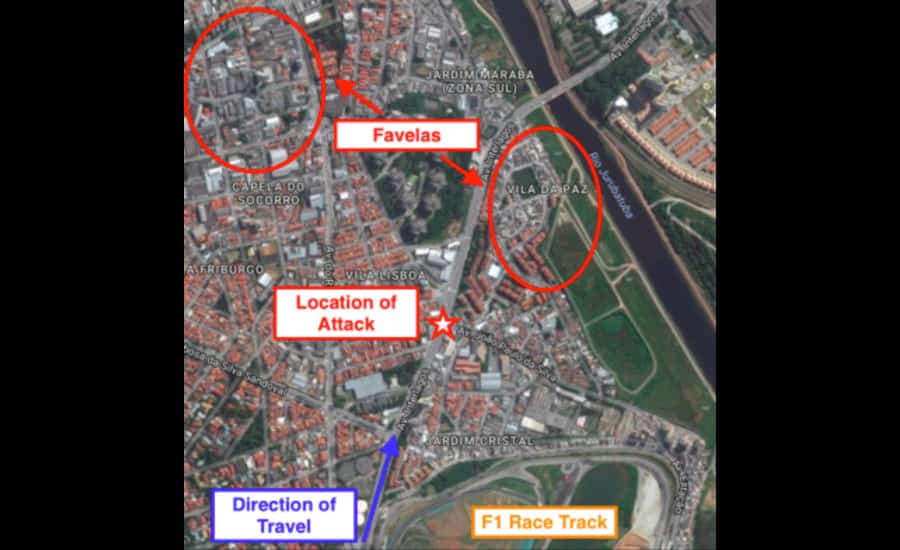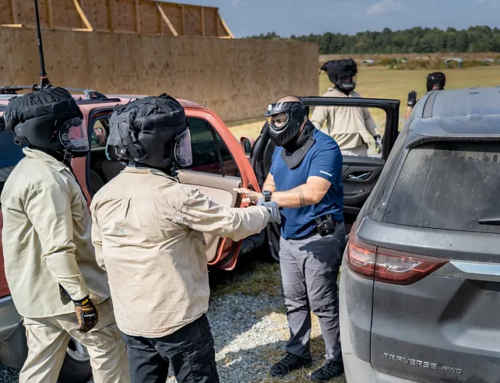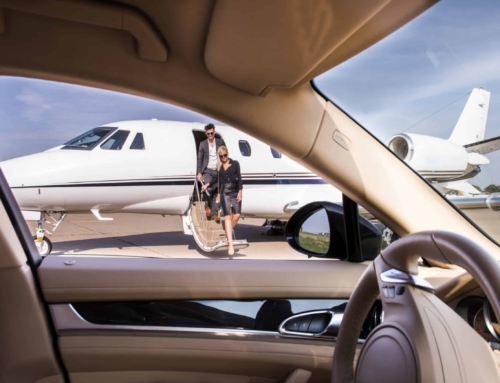
In 2017, after the Brazilian Grand Prix, a Mercedes F1 Grand Prix team minibus full of team members leaving the F1 Circuit in Sao Paulo was robbed at gunpoint. Valuables were stolen from the minibus during the attack. The robbery occurred after the minibus left the circuit that evening en route to the team hotel. Just 48 hours later, a Pirelli Team car was subject to an attempted armed robbery near the same location.
This was not an unprecedented Grand Prix incident. In 2010 former McLaren driver Jenson Button was the victim of an attempted armed attack when his vehicle was threatened at gunpoint as he left the circuit. Through aggressive evasive maneuvers by his driver, Button was able to escape unharmed. In 2007, a Toyota team bus was also held up in a similar area of Sao Paulo.
Armed Attack
On a Friday evening, the minibus (non armored) with Mercedes F1 team mechanics was assaulted by approximately eight armed men near the exit of the circuit. Unconfirmed police reporting suggested the vehicle was attacked while traveling North on Av. Interlagos towards the bridge.
While stopped in traffic, the vehicle was surrounded and the criminals ordered the back door to be opened. Team members were robbed of their belongings and cash.
After robbing the Mercedes van, the thieves tried to stop a van with Federation Internationale de l’Automobile (FIA) employees, but the van was armored and managed to evade the robbers. Police intelligence indicated the eight men were believed to be armed with pistols and machine guns. The subjects fired shots at the escaping FIA vehicle, but fortunately no one was hurt.
There are two main favelas in close proximity to the incident as marked on the map above (image 1). Also, traffic is notoriously congested in the area, and with only two primary bridges leading North toward the main city center, there are few opportunities for alternative routes. (See image 2.)
What Went Wrong
From speaking with Brazilian police contacts, it appears that the local criminal gangs have spotters at the circuit and identify key vehicles leaving the circuit. According to sources, the attackers developed intelligence on F1 support teams using a lot of cash instead of credit cards. This made the victims an easy high-worth target. This information should have led team security to consider a high-profile security presence to serve as a visual deterrent to the criminal gangs. By using a high-profile security convoy, there could have been advance and support security vehicles, as well as armored vehicles for key personnel. Motorbikes in advance and support could also have been utilized as these have proven to be an effective deterrent due to their capability to follow in heavy traffic and narrow streets and to react quickly to an incident.
A high-profile security methodology in Brazil has been previously successful, including during the 2016 Summer Olympic Games. The visual display allows criminals to clearly see that an armed, professional security detail is present, and the criminals often move on to an easier target. It is also unlikely that the teams were liaising with local law enforcement. For example, liaison with the Policia Militar may have resulted in sharing of known intelligence and even provision of a marked police escort, or an agreement to position some police vehicles and personnel (in force) at the key high-risk areas. This, in conjunction with the high-profile private security detail, would have been commensurate with risk and the ideal way to counter the obvious and very real threats in Brazil.
Not Just a VIP Problem
Brazil is ranked by the U.S. State Department with a Critical threat level of crime, with the main threat being opportunistic crime. Although opportunistic, all crime in Brazil has the risk of turning hyper violent and escalating quickly to deadly force – literally in seconds if orders are not complied with immediately or any disrespect is shown or inferred.
Brazil can lull you into a false sense of security. The majority of the people are friendly, the scenery enticing, and the culture mesmerizing. Many trips can go by without incident. However, there is a credible and significant risk of violent crime, and all business travelers are at high risk of opportunistic crime no matter what your company, role or reason for travel.
There is a propensity for violence in Brazil unlike many other countries, fuelled by massive disparity of wealth, the easy availability of firearms, the influence (and power) of drug- and arms-trafficking gangs, and under funded and ineffective policing.
Each year a number of foreigners are killed or injured during attempted robberies, car-jackings and express kidnaps, the majority of targeted victims do not have personal security, or have not carried out basic security protocol.
Armed gang raids on restaurants, bars, roads and beaches are not uncommon in Brazil. An increasing number of such incidents take place in or near wealthy neighborhoods or tourist areas which are likely to be frequented by business travelers.
Violent Crime
Brazil’s murder rate is more than four times higher than that of the United States, and rates for other crimes are similarly high. Brazilian crime rates are rising. There are no buffer zones – due to the close proximity at all times to dangerous areas. Major transit routes are close to favelas and even high scale, upper class, expensive communities are not safe from the threat of crime.
Foreign tourists are especially vulnerable to petty crime. Thieves are active at outdoor markets, airports, tourist sites, hotel lobbies, bus stations and other public places. Although most victims are locals, foreigners should exercise caution at all times. Most victims of crime are local residents, though each year a number of foreigners are killed or injured during attempted robberies, car-jackings and opportunistic crime – with casualties often caused by resisting or complicating the situation.
The Brazilian prosecution rate is extremely low and not enforced on subjects under age eighteen. Therefore, the majority of snatch and grab criminals are under 18. There are very few ramifications or deterrents for other criminals and so the police face an uphill struggle.
Gang-related violence has been increasing in the surrounding metropolitan areas of Rio de Janeiro and São Paulo as a result of turf wars between cells affiliated with the Premeiro Comando de Capital (PCC), Brazil’s largest criminal organization with 13,000 members, and the Rio de Janeiro-based Red Command (CV), amongst other smaller groups.
The São Paulo state Public Security Ministry reported a 31.5% increase in homicides in greater São Paulo between January and March compared to the same period in 2016; local media reports indicate that the spike is related to a turf war between the PCC and the Brazilian Revolutionary Criminal Command (CRBC) – a local gang based in Guarulhos city (São Paulo state).
According to the New York Times: “A little more than a year since Rio de Janeiro hosted a largely successful Summer Olympics, Brazil’s showcase city is plagued by a rise in lawlessness reminiscent of its darkest periods in the 1980s and 1990s. There were 4,974 people killed in Rio de Janeiro State, with a population of about 16.5 million, during the first nine months of this year, up 11 percent from last year, according to state government statistics.”
Pushing the Gate Ajar After The Horse Has Bolted – Avoid This – Be Proactive
A common mistake by many organizations, is to adopt the security mindset of “Well, nothing has happened yet, and we have been there multiple times” coupled with the false belief that “authorities are aware and adapting accordingly so we will be ok next time.”
There are always promises of increased security presence after such attacks. Yet time and time again these are proven ineffective at best, and provide a false sense of security at worse. In Brazil, the Policia Militar are heavily overstretched, underpaid for the dangerous job they perform, and understaffed. In other countries, after an attack, police and military surge to show visual presence but are soon scaled back, and “normality” resumes.
The Grand Prix circuit has a police station in close proximity, and there were multiple police vehicles and bikes nearby but just randomly positioned. Criminals and gangs in Brazil are rarely intimidated by an uncoordinated police presence and often carry out seemingly audacious and violent attacks with no apparent concern of police response. Brazilian criminals know that a firm, effective and timely law enforcement response is highly unlikely. The thugs can retreat to the relative safety of their favelas through small, maze-like alleys, and traffic congestion prevent police from pursuing.
Corporate and VIP security details in Brazil must look to be self-sufficient for the entire duration of their trip, and to cover all of their staff, not just the VIPs, accordingly.
Lessons Learned in Brazil Cross Decking to Global Business Travel
- Journey management is key for travel, wherever the destination – Consult security professionals and avoid ride share services and self-drive. Strongly consider the use of private transportation services.
- Armored vehicles are not just for VIPs – If the risk assessment suggests that armored vehicles are required for movement of personnel, this should cross deck to all personnel, or at least move towards an amended security plan that mitigates and manages risk to an acceptable level.
- Armored vehicles on their own do not provide security – Any use of armored vehicles must be used in conjunction with a solid, intelligence led security plan. These types of vehicle are useful, but must be supported by intelligence-led security protocol, armed response and support services.
- Travel safety briefings for staff pre-travel – “Know before you go” about the threats, how to minimize risk, and how to react if the worse case scenario ever does occur are vital.
Utilize a company with extensive links to the police and intelligence agencies to assist with interoperability, intelligence, communication and assistance in-case of an emergency.




